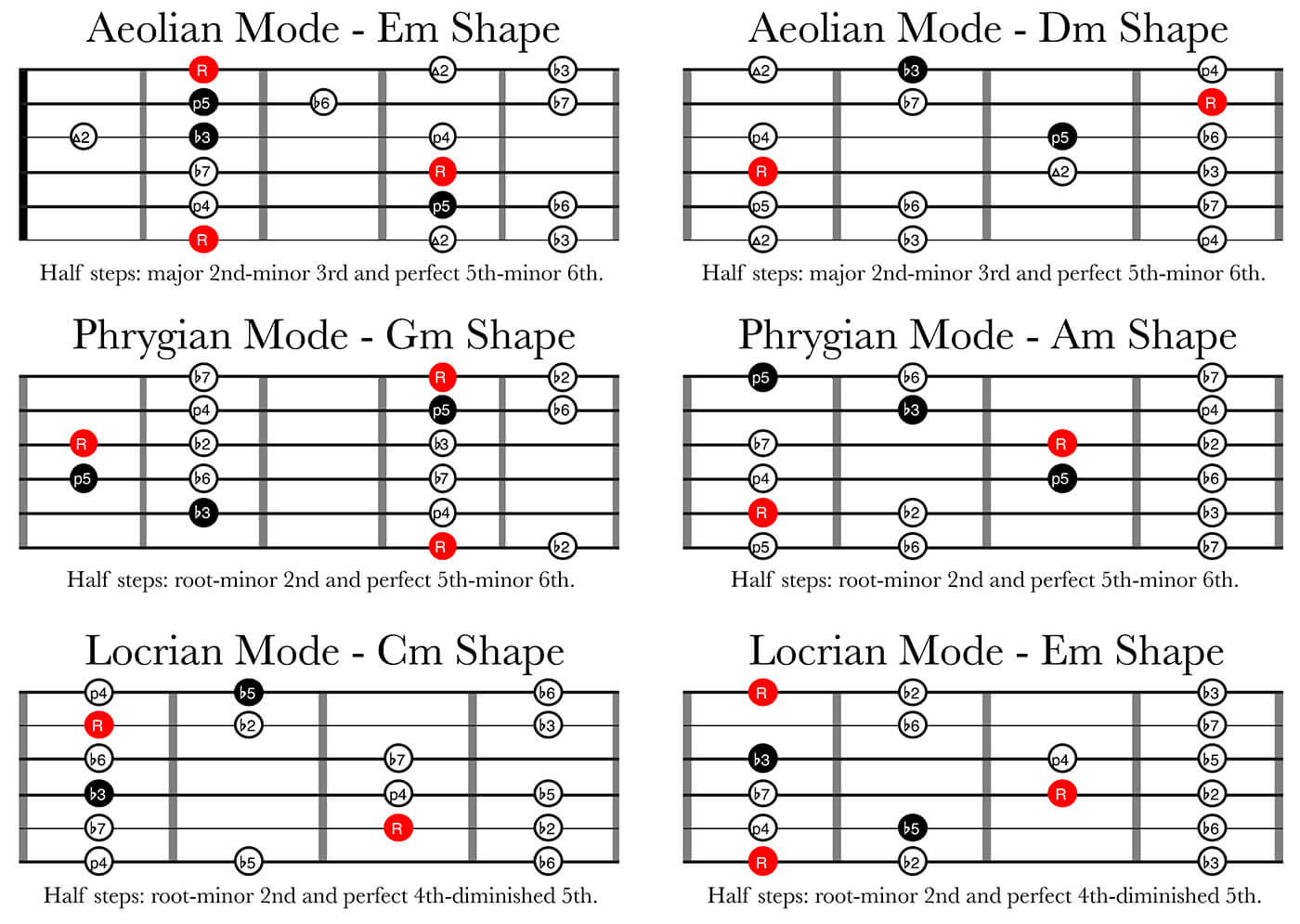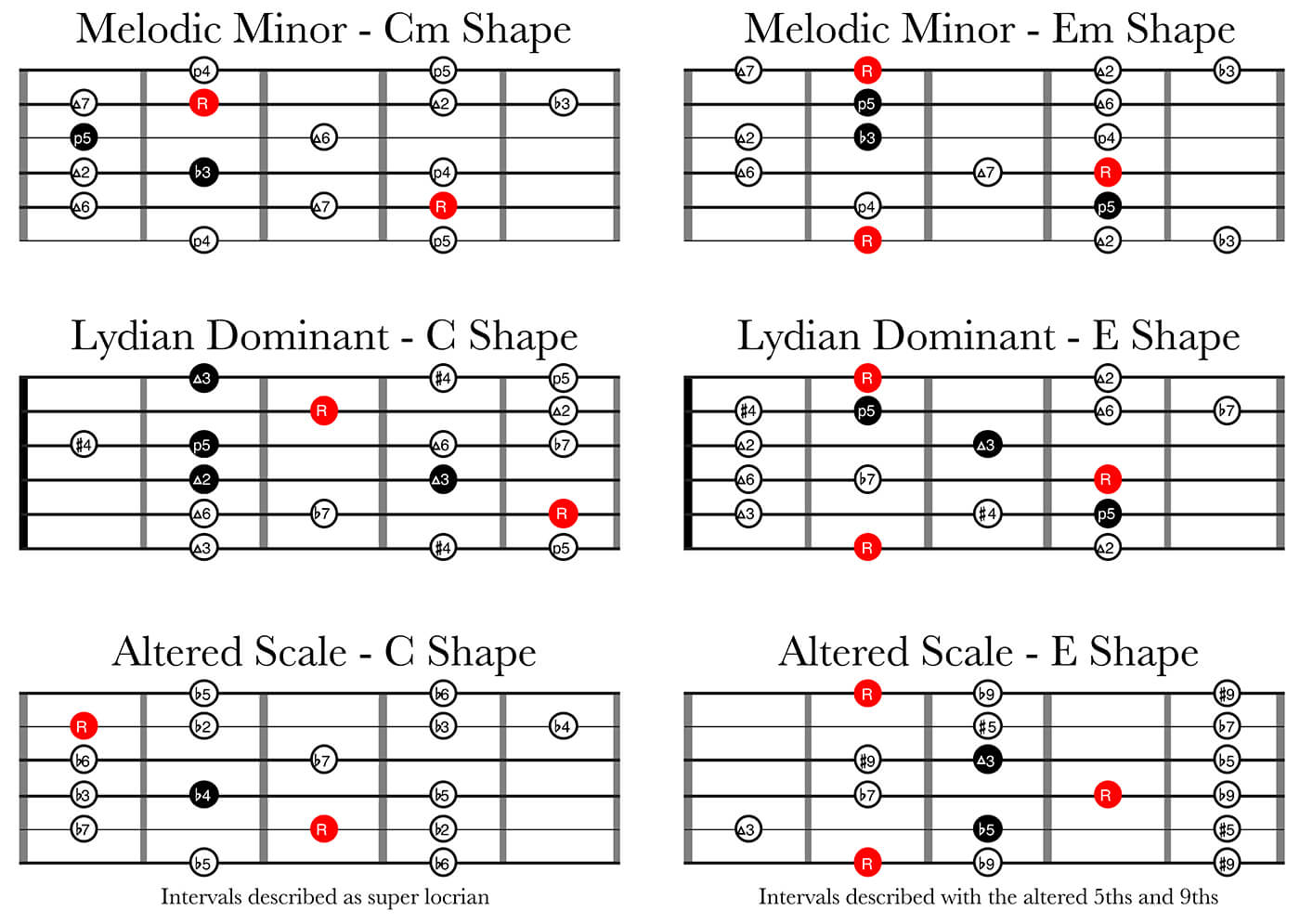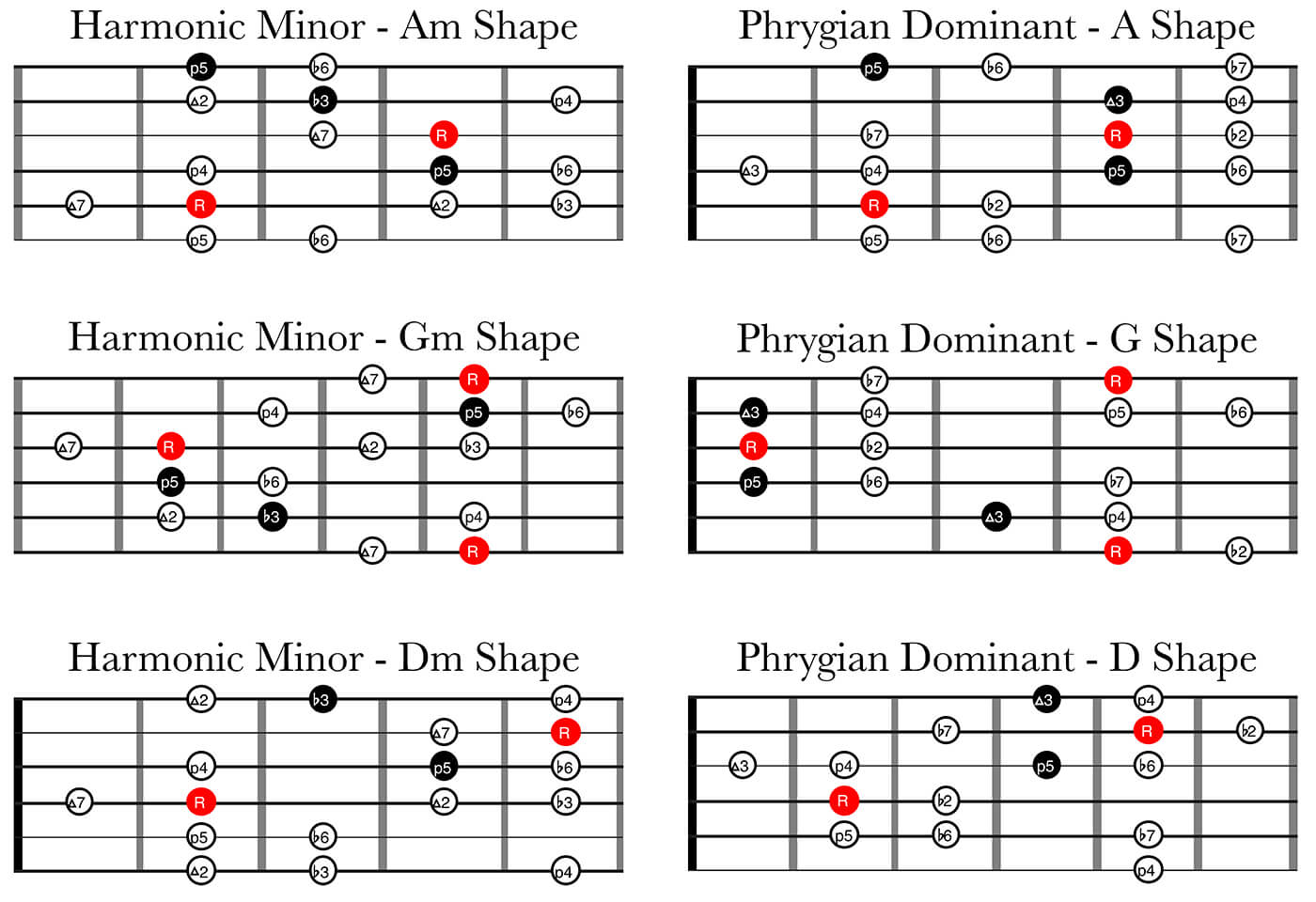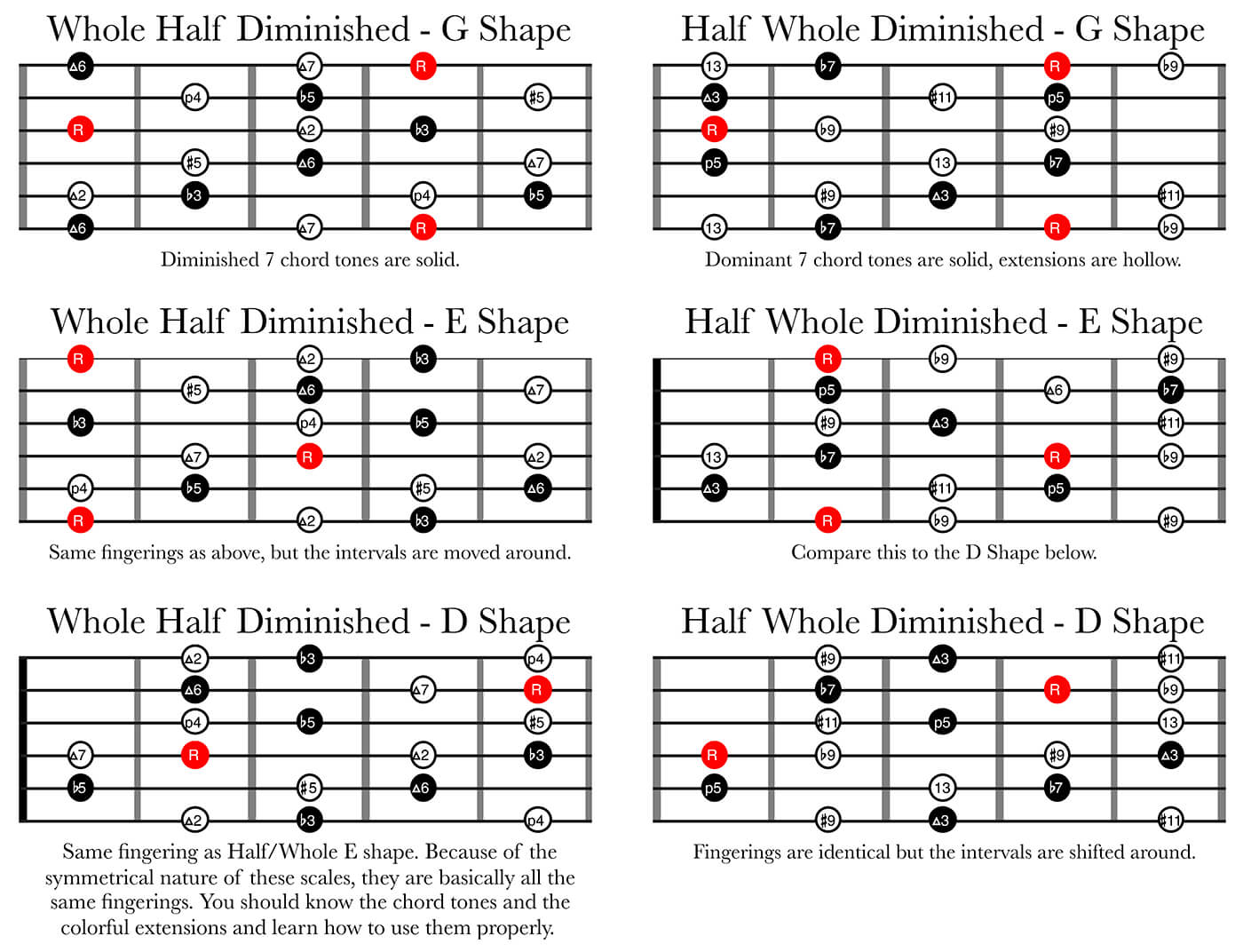Related Tags
How to get better at guitar using the CAGED system (Part 6)
In the final part of his invaluable series about the humble CAGED system, we bring it all together – it’s time for a solo.

Image: Getty Images
We’ve arrived to the sixth and final part of this lesson series about the CAGED System. If you haven’t checked out the previous parts yet, I advice you to do that before working on the content in this article.
From this point, I’ll assume that you have a good understanding of how major and minor triads, pentatonic scales, the major scale and the chromatic scale are related to the CAGED System. Now let’s dive deeper with even more scales that we can use for soloing!
The Modes of the Major Scale
We’ll use the pentatonic major and minor scales as our starting points here. Both of these are five-note scales so we will add two more notes to get the seven modes of the major scale.
It’s quite common to show all these scales starting from C major and then change the starting point of the scale. The downside to this is method, in my opinion, is that you basically won’t hear any difference if you don’t have a harmony established underneath.
Instead, I’m gonna show you all of these scales with C as the root note. The major pentatonic and minor pentatonic scales don’t have any half-step intervals so the notes we’re gonna add will create half steps that will establish the character of each of these seven modes. I sometimes call this ”The Power of the Half Steps” – you’ll hopefully see what I mean as we continue.
The major pentatonic has the following formula: 1-2-3-5-6 – then we add the 2 and the 7 for our full 1-2-3-4-5-6-7 major scale.
In the key of C, the major scale contains these notes: C-D-E-F-G-A-B-C. The half steps are between E-F (major 3rd-perfect 4th) and B-C (major 7th-root). This is stuff we’ve talked about before but it’s essential to understand this to really get the most out of the modes.
The major scale is also called the C Ionian Mode. Now let’s alter this by raising our perfect 4th (F) a half step to an augmented 4th (F♯). This moves one of our half steps so it’s now occurring between the F♯-G (augmented 4th to perfect 5th) instead of E-F (major 3rd to perfect 4th) – this changed the sound of this scale quite a lot. It’s now called the C Lydian mode and since it still contains the major 3rd and major 7th it still works really well over major chord and maj7 chords. But with the ♯4 (F♯) now being a scale note it also sounds really good over a Cmaj13♯11 or D/C as well.
Why does it work over a D/C? Check out the relationship between the C major pentatonic, C Ionian and C Lydian in the A, G and D shapes here:

Raising the 4th degree of the scale gave the Lydian Mode a certain sound that often is described as ”brighter” than the Ionian Mode (regular major scale). So what happens if we start to lower notes instead, would that give us a ”darker” sound instead?
Let’s try by first reverting to the C major scale and then lower the major 7th to a minor 7th (the same as a flat 7th, both terms are widely used). The formula would then be: 1-2-3-4-5-6-♭7. The notes would be? This is called the C Mixolydian Mode. Since it contains the root, major 3rd, perfect 5th and flat 7th, it’s commonly used over dominant chords such as C7, C9, C13 and so on.
Let’s continue by flattening another scale note, let’s lower the major 3rd. That’ll give us the following notes: C-D-E♭-F-G-A-B♭.
Can you figure out the scale formula? This is called the C Dorian Mode and works really well over chords like Cm, Cm7, Cm9, Cm11 and vamps like Cm7-F7. To my ears Mixolydian and Dorian both sounds like a nice mix between major and minor, the flat 7th gives Mixolydian a little minor flair while the major 6th gives the Dorian a little major vibe. Both of these modes share the half step interval between the A-B♭ (major 6th-flt 7th) – I want you to figure out what sets them apart from each other. Hint: check where the other half step occur in each mode.
Do you think lowering the 7th and then also the 3rd made these modes sound darker than the Ionian and Lydian? Let’s check them out on the fretboard, now in the C and E shapes:

Now I’m showing this with a method of altering one note at a time, starting from the major scale. There’s are other ways to think of this as well that I’ll present further down. But let’s check out the last three modes first.
Now starting from Dorian, we’ll lower the 6th scale degree. Can you figure out both the note names and the formula of this mode?
The new mode is called C Aeolian Mode and it’s the same notes as the natural minor scale. To my ears, the sound has now definitely gotten darker compared to where we started. We can modify this scale in another few ways; by lowering the 2nd degree we’ll end up with the following formula: 1-♭2-♭3-4-5-♭6-♭7. This is called the C Phrygian Mode.
The only note, except for the root, that we haven’t altered by now is the perfect 5th – when we lower that we’ll end up with the C Locrian Mode and these notes: C-D♭-E♭-F-G♭-A♭-B♭.
I was gonna ask you about the formula but by now you should get that I advise you figure these things out, right? Check out a few fingerings of these modes and where the half steps occur down below:

To summarise what we’ve done so far: we started with the major scale (also called Ionian Mode) and then raised the 4th degree which gave us the brightest sounding mode (Lydian). After reverting back to Ionian we started lowering one scale degree at a time, each time finding a slightly darker sound. In this way the modes can be arranged ”in order of brightness” like this:
Mode
Formula
Chords to play the modes over
Lydian
(1-2-3-♯4-5-6-7)
Major triad, maj7, maj9, maj9♯11 etc.
Ionian
(1-2-3-4-5-6-7)
Major triad, maj7, maj6 etc.
Mixolydian
(1-2-3-4-5-6-b7)
Dom7, dom9, dom11, dom13 etc.
Dorian
(1-2-♭3-4-5-6-♭7)
Minor triad, m6, m7, m9, m11 etc.
Aeolian
(1-2-♭3-4-5-♭6-♭7)
Minor triad, m7, m9, m11, m7(♭13) etc.
Phrygian
(1-♭2-♭3-4-5-♭6-♭7)
Minor triad, m7, sus4♭9 etc.
Locrian
(1-♭2-♭3-4-♭5-♭6-♭7)
Diminished triad, m7♭5 etc.
Another way of thinking of this is to relate three scales to major and four scales to minor based on if they have a major or minor 3rd in their formula. The major scale formula is 1-2-3-4-5-6-7 so the Lydian mode is sometimes just described as a major scale with a ♯4 while the Mixolydian mode is called a major scale with a b7. The minor scale (same as aeolian mode) formula is 1-2-♭3-4-5-♭6-♭7 so the Dorian can be called minor scale with a major 6th, the Phrygian is a minor scale with a b2 while the Locrian is a minor scale with a ♭2 and ♭5.
I’m a proponent for learning how to understand this from different angles, but of course it might be a bit too intense to learn it all at once so take your time.
One of the most common ways to talk about the modes of the major scale is to play the notes of the C major scale (for example) but from different starting points, seeing each note as a new root. I learned it this way, but nowadays I prefer one of the strategies mentioned above.
It’s better to keep the same harmonic centre (C) and then change the notes you are playing rather than staying with the same fingerings and letting the harmonic background (a backing track, loop pedal or a friend playing chords) change the sound of the notes you are playing. I don’t want to leave out this option as it’s very common.
Playing the notes from C major but with different starting points will give you the modes in the following order:
C-D-E-F-G-A-B
C Ionian Mode
1-2-3-4-5-6-7
D-E-F-G-A-B-C
D Dorian Mode
1-2-♭3-4-5-6-♭7
E-F-G-A-B-C-D
E Phrygian Mode
1-♭2-♭3-4-5-♭6-♭7
F-G-A-B-C-D-E
F Lydian Mode
1-2-3-♯4-5-6-7
G-A-B-C-D-E-F
G Mixolydian Mode
1-2-3-4-5-6-♭7
A-B-C-D-E-F-G
A Aeolian Mode
1-2-♭3-4-5-♭6-♭7
B-C-D-E-F-G-A
B Locrian Mode
1-♭2-♭3-4-♭5-♭6-♭7
Melodic minor
The formula of the natural minor scale is 1-2-♭3-4-5-♭6-♭7. By raising the 6th and 7th degrees we’ll get the Melodic Minor Scale. In the key of C, the notes would be C-D-E♭-F-G-A-B – what would be the formula for this new scale?
If you compare this to the C major scale, you should notice that it’s only the 3rd that is flattened. The rest is exactly the same. In the melodic minor scale, the half steps occur between the major 2nd-minor 3rd (D-E♭) and B-C (major 7th-root). All the seven modes derived from the major scale has two half-step intervals separated by either two or three consecutive whole steps. The melodic minor changes this sequence and has the two half-step intervals separated by one and four consecutive whole steps. Check this comparison where -W- stands for whole step and -H- means half step:
C Major Scale
C -W- D -W- E -H- F -W- G -W- A -W- B -H- C
C Melodic Minor Scale
1 2 1 2 3
C -W- D -H- Eb -W- F -W- G -W- A -W- B -H- C
1 � 1 2 3 4
This makes the sound of all the modes derived from melodic minor stand out quite a bit compared to the sounds of the major scale modes. We’ll look into two of the most common ones that are both used frequently over dominant chords.
Lydian Dominant is built from the 4th degree of the melodic minor scale. As the name implies, it has characteristics from both the Lydian mode and a dominant chord, so we’ll simply take our lydian formula and then lower the 7th degree giving us the following notes in the key of C: C-D-E-F♯-G-A-B♭. This works well to give some ‘outside’ vibe over a dominant chord and outlines the harmony perfectly when played over a C7(♯11).
The Altered Scale is built from the 7th degree of the melodic minor scale and works really well over altered dominant chords. In Part 4 of this lesson series, I explained what this means, but basically it’s a dominant chord where the 5th and/or 9th degree has been sharpened/flattened. This is also called the Super Locrian scale since it’s basically the locrian mode with the 4th degree flattened: 1-♭2-♭3-b4-♭5-♭6-♭7. To see its connection to altered dominant chords, it’s also possible to describe the formula as: 1-♭9-♯9-3-♭5-♯5-♭7.
Let’s check this three out on the fretboard:

Harmonic minor
The formula of this new scale is: 1-2-♭3-4-5-♭6-7. In the key of Cm, what are the notes? We can also refer to it as a minor scale with a major 7th. Both the major scale and the melodic minor scale are built off of a series of half and whole steps between their respective scale degrees. And they both have two half steps and five whole steps.
When we get into the Harmonic Minor Scale we’ll have three half steps, three whole steps and one interval that is a step and a half (or a minor third/augmented second). This changes things quite drastically. The Phrygian Dominant is built from the 5th degree of the harmonic minor and combines the Phrygian character interval, a minor 2nd, with the major 3rd and flat 7th from a dominant chord so it works really well over a C7(♭9) chord. The formula is: 1-♭2-3-4-5-♭6-♭7. It sounds quite exotic and is commonly used in music from India, the Middle East, Eastern Europe, Central Asia and in flamenco. Here are some fingerings for these two scales:

Diminished
The diminished scales are symmetrical in their formation. There are two variations where one is called Whole Half Diminished and the other one Half Whole Diminished – the names describes their respective sequence of half and whole steps. The whole half diminished is commonly used over diminished 7th chords and has the following formula: 1-2-♭3-4-♭5-♯5-6-7.
Wait – this scale has 8 notes? Yup, it has four whole steps and four half steps sequenced as:
C -W- D -H- E♭ -W- F -H- Gb -W- A♭ -H- A -W- B -H- C
The half whole diminished does the opposite and starts with a half step instead:
C -H- D♭ -W- E♭ -H- E -W- F♯ -H- G -W- A -H- B♭ -W- C
This second one is commonly used over dominant chords since it has all the four notes from a dominant 7th arpeggio: the root, major 3rd, perfect 4th and flat 7th. It also contains the ♭9, ♯9, ♯11 and major 13th. Four very safe, harmonically stable, intervals – and four notes that add a lot of flavour when used in the right way.
Let’s head over to the fretboard:

This was quite a deep dive into scales, knowing your intervals and how to understand the scale formulas make it quite easy to get them under your fingers. But that’s just the start, making music with the different scales is much harder than just memorising some fingerings or formulae. So make sure to take your time, don’t stress, work on one or two scales at a time. Don’t try to learn them all at once. This is stuff that’ll benefit your playing in the long run so be patient – I promise it’ll be worth it!
Thanks for reading and if I can give one final advice: go back from the start and go through these six lessons again and see how much has stuck in your head and fingers along the way. Then you can start working on small bits and pieces and incorporate it into your playing. The guitar fretboard is truly tied together with the CAGED System – use it the best way you can to tie together your musical visions. See ya!
Learn from your favourite guitar players here.
